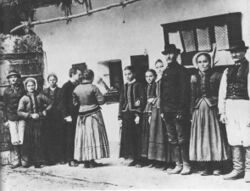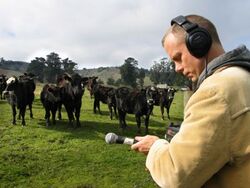Engineering:Field recording
Field recording is the term used for an audio recording produced outside a recording studio, and the term applies to recordings of both natural and human-produced sounds. It also applies to sound recordings like electromagnetic fields or vibrations using different microphones like a passive magnetic antenna for electromagnetic recordings or contact microphones. For underwater field recordings, a field recordist uses hydrophones to capture the sounds and/or movements of whales, or other aquatic organisms. These recordings are very useful for sound designers.
Field recording of natural sounds, also called phonography (a term chosen to illustrate its similarities to photography), was originally developed as a documentary adjunct to research work in the field, and foley work for film. With the introduction of high-quality, portable recording equipment, it has subsequently become an evocative artform in itself. In the 1970s, both processed and natural phonographic recordings, (pioneered by Irv Teibel's Environments series), became popular.
"Field recordings" may also refer to simple monaural or stereo recordings taken of musicians in familiar and casual surroundings, such as the ethnomusicology recordings pioneered by John Lomax, Nonesuch Records, and Vanguard Records.
Techniques
Field recording often involves the capture of ambient noises that are low level and complex, and, in response, the requirements from the field recordist have often pushed the technical limits of recording equipment, that is, demanding low noise and extended frequency response in a portable, battery-powered unit. For this reason, field recordists have favoured high-quality (usually professional) recorders, microphones, and microphone pre-amplifiers. The history of the equipment used in this area closely tracks the development of professional portable audio recording technology.
Field recording is typically recorded in the same channel format as the desired result, for instance, stereo recording equipment will yield a stereo product. In contrast, a multitrack remote recording captures many microphones on multiple channels, later to be creatively modified, augmented, and mixed down to a specific consumer format.
Field recording experienced a rapid increase in popularity during the early 1960s, with the introduction of high-quality, portable recording equipment, (e.g., the Uher, and Nagra portable reel-to-reel decks). The arrival of the DAT (Digital Audio Tape) in the 1980s introduced a new level of audio recording fidelity with extended frequency response and low self-noise. In addition to these technologies, other popular means for field recording have included the analog cassette (CAC), the DCC (Digital Compact Cassette), and the MiniDisc. The latest generation of recorders are completely digital-based (hard disk/Flash). It is also possible to use personal electronic devices, (e.g., a smartphone or tablet), with software, to do field recording and editing.
Newly developed techniques include the creative placement of microphones, (including contact microphones and hydrophones, for example), the diffusion of captured sounds, and individual approaches.
Research
Ethnomusicology

Field recording was originally a way to document oral presentations and ethnomusicology projects (pioneered by Béla Bartók, Charles Seeger, and John Lomax). In the case of Bartók, his own studies helped alter the generally unfavorable view of Eastern European folk music at that time. He grew to admire numerous regional styles from both firsthand experience and recordings, eventually incorporating these styles into his own compositional works.[1]
Bioacoustics
Field recording is an important tool in bioacoustics and biomusicology, most commonly in research on bird song. Animals in the wild can display very different vocalizations from those in captivity. Ambient noise in urban environments have also shown to alter the vocalizations of local bird populations.[2]
Art
Music
The use of field recordings in avant-garde, musique concrète, experimental, and, more recently, ambient music was evident almost from the birth of recording technology. Most noteworthy for pioneering the conceptual and theoretical framework with art music that most openly embraced the use of raw sound material and field recordings was Pierre Schaeffer, who was developing musique concrète as early as 1940. Further impetus was provided by the World Soundscape Project, initiated by Canadian composer R. Murray Schafer in the 1970s; this work involved studying the acoustic ecology of a particular location by the use of field recordings.
Field recordings are now a common source material for a range of musical results, from contemporary musique concrète compositions to film soundtracks, video game soundtracks, and effects. Chris Watson, formerly of Cabaret Voltaire, is now perhaps the world's leading exponent of this art, with his recordings used for David Attenborough's series for the BBC, programmes for BBC Radio, and many other outlets. Another notable application of field recordings as of contemporary music is its inclusion in some vaporwave tracks, commonly recordings of public areas such as malls or grocery stores to add atmosphere.
The sounds recorded by any device, and then transferred to digital format, are used by some musicians through their performance with MIDI-interfaced instruments. A contemporary artist with great success for his compositions is Christian Fennesz.
Earlier innovators who are noted for the importance and boldness of their projects are Luigi Russolo, who, in 1913, with his manifesto, L'arte dei rumori (The Art of Noises), gave musical value to environmental noise. He also designed and built the Intonarumori—the first instruments for making noise. Francesco Balilla Pratella utilized the Intonarumori in his opera, L'aviatore Dro, which was written in close collaboration with Filippo Tommaso Marinetti, (the founder of the Futurist movement).
Radio documentary
Radio documentaries often use recordings from the field, e.g., a locomotive engine running, for evocative effect. This type of sound functions as the non-fictional counterpart to the sound effect.
Politics
During the early years of commercial recordings, the speeches of politicians sold well, since few people had radios. The HMV ("His Master's Voice") catalogue for 1914–1918[3] lists over a dozen such records. Probably the last time such records sold well was in 1965, when the LP, The Voice of Churchill, reached number 7 in the UK album charts. This was immediately after Churchill's death.
See also
- Biomusic
- Lowercase
- The Freesound Project
- Sound art
- Soundscape
- Sound map
References
- ↑ Cedarville University; Nelson, David (2012). "Béla Bartók: The Father of Ethnomusicology". Musical Offerings 3 (2): 75–91. doi:10.15385/jmo.2012.3.2.2. http://digitalcommons.cedarville.edu/musicalofferings/vol3/iss2/2/.
- ↑ Warren, Paige S.; Katti, Madhusudan; Ermann, Michael; Brazel, Anthony (2006). "Urban bioacoustics: it's not just noise" (in en). Animal Behaviour 71 (3): 491–502. doi:10.1016/j.anbehav.2005.07.014. https://linkinghub.elsevier.com/retrieve/pii/S0003347205004379.
- ↑ Gramophone records of the First World War : an HMV catalogue, 1914-1918 (Book, 1975) [WorldCat.org]
External links
 |



